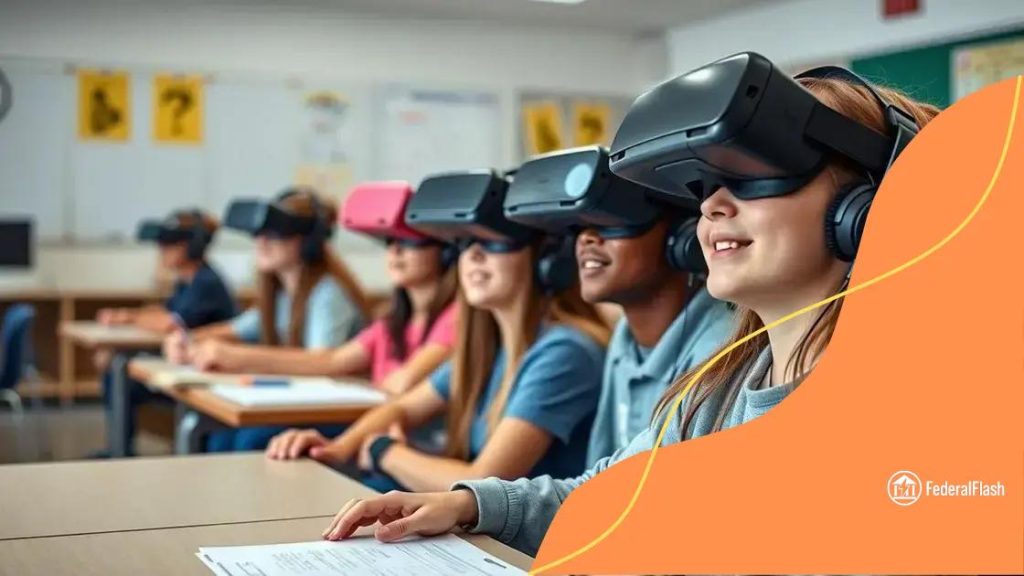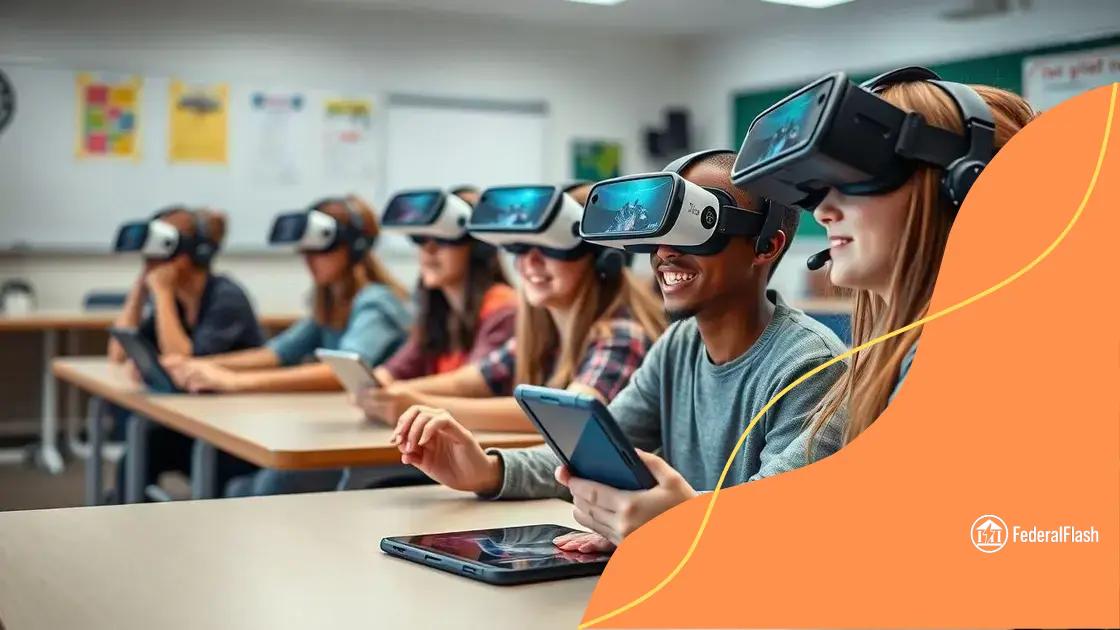VR/AR shaping modern learning experiences

Anúncios
VR and AR technologies are transforming modern learning by providing immersive, interactive experiences that enhance student engagement, personalize education, and facilitate collaboration across various subjects.
VR/AR shaping modern learning is not just a buzzword; it’s a game-changer in the educational landscape. Imagine stepping into a virtual world where lessons come to life and concepts become tangible. Interested?
Anúncios
Understanding VR and AR in education
When we talk about VR and AR in education, we’re diving into exciting technologies that are changing the way students learn. These tools create engaging environments that can enhance understanding and retention of information. But what exactly are they? Let’s break it down.
What is VR?
Virtual Reality (VR) immerses students in a computer-generated environment. It allows them to explore places and scenarios that might be impossible in real life, like walking on the surface of Mars or visiting ancient civilizations. By wearing a VR headset, learners can interact with their surroundings, providing a deeply engaging educational experience.
What is AR?
Augmented Reality (AR), on the other hand, overlays digital information onto the real world. It adds layers of information on top of what we see and can be accessed with smartphones or tablets. Imagine seeing 3D models of human anatomy or historical artifacts right on your desk! This helps students visualize abstract concepts and see the real-world application of their studies.
Anúncios
Benefits of VR and AR in education
- Increased engagement: Students are more motivated to learn when they can interact with the content.
- Enhanced retention: Immersive experiences help students remember information better.
- Safe learning environments: Students can experiment without real-world consequences, especially in science or history.
Incorporating VR and AR in classrooms is not just a trend; it’s a necessity for the future of education. These tools provide opportunities for experiential learning that textbooks alone cannot offer. Imagine students collaborating on virtual projects across the globe or conducting science experiments in a controlled virtual lab. The potential of these technologies to enrich education is vast and exciting. So, are you ready to see how VR and AR can reshape the learning experience?
Benefits of immersive learning experiences
Immersive learning experiences offer a wide array of benefits that enhance education. When students engage with material in a hands-on way, they are more likely to grasp complex ideas. Let’s explore some key advantages.
Increased Engagement
Immersive learning creates an exciting atmosphere for students. When they can interact with content through VR and AR, they become active participants in their education. This level of engagement can lead to a deeper interest in the subject matter.
Better Retention of Information
Studies show that students who participate in immersive learning are more likely to retain what they’ve learned. This is because the experience involves multiple senses, making the information more memorable. For example, experiencing a historical event through VR can create lasting memories.
Real-World Applications
- Practical experience: Students can apply their knowledge in simulations that mimic real-life scenarios.
- Skill development: Immersive environments can help learners practice skills before applying them in real situations.
- Critical thinking: Students are often challenged to solve problems in immersive settings, enhancing their critical thinking skills.
In addition to these benefits, immersive learning fosters collaboration among students. When approached in teams, learners can share perspectives and learn from each other. This interaction not only builds communication skills but also encourages a culture of teamwork. With immersive technologies becoming more accessible, the potential for transforming education is limitless. Overall, immersive learning experiences create an environment where students can thrive academically and socially.
Integrating VR/AR technology in classrooms

Integrating VR and AR technology in classrooms can transform the learning experience for students. These immersive tools encourage hands-on learning and make education more interactive. To successfully adopt these technologies, educators need to understand how to implement them effectively.
Starting with Planning
Before teachers can integrate VR and AR into their classrooms, planning is essential. Educators should consider the specific goals they want to achieve with these technologies. Identifying the curriculum areas that could benefit from immersive tools will help guide the selection of suitable apps and devices.
Choosing the Right Tools
Selecting the right VR and AR tools is critical. There are many available platforms that cater to different educational needs. Here are a few factors to consider when making a choice:
- User-friendliness: The technology should be easy for both teachers and students to use.
- Content relevance: Ensure the content aligns with curriculum standards.
- Accessibility: Make sure all students can access the technology, regardless of their background.
As technology becomes more integrated into classrooms, training for teachers becomes an important aspect. Workshops and professional development sessions can help educators feel more confident in using VR and AR tools. This training can cover how to create engaging lessons and troubleshoot issues that may arise.
Encouraging Collaboration
Integrating VR and AR can also encourage collaboration among students. They can work in groups to solve problems or complete tasks, adding an essential social element to learning. For instance, a project using virtual simulations allows teams to interact and discuss their findings in a safe environment.
Overall, incorporating VR and AR technology into classrooms fosters a dynamic learning atmosphere. As educators embrace these tools, they open the door to new possibilities that can inspire students and enhance learning outcomes.
Case studies of successful implementations
Studying case studies of successful implementations of VR and AR technology in education shows how effective these tools can be in enhancing learning experiences. Schools around the world have adopted these technologies, providing valuable insights into their benefits.
Case Study: Virtual Reality in History
A high school in California used VR to teach students about ancient civilizations. By immersing students in virtual scenarios, they could explore the pyramids of Egypt and the streets of Rome. This hands-on experience helped spark interest in history, leading to higher test scores and increased student engagement.
Case Study: Augmented Reality in Science
In a middle school in New York, teachers integrated AR technology into their science curriculum. Using AR applications, students could visualize complex structures like the human body and ecosystems. This interactive approach allowed them to manipulate 3D models and better understand scientific concepts.
Key Takeaways from Implementations
- Improved Engagement: Students were more interested in lessons when using VR and AR.
- Enhanced Understanding: These technologies provided clear visualizations, making learning more accessible.
- Collaboration: Students worked together to complete tasks, fostering teamwork and communication skills.
Schools have also seen an increase in creativity as students think outside the box while using immersive technologies. For instance, students designing their own virtual environments learned to apply problem-solving skills and critical thinking. By examining successful case studies, educators can better understand how to implement VR and AR in their classrooms effectively.
Future trends in VR/AR educational tools
The future of VR and AR educational tools looks very promising. These technologies are evolving rapidly, offering exciting possibilities for enhancing how students learn. As we look ahead, several trends begin to emerge that educational institutions should consider.
Increased Accessibility
With advancements in technology, VR and AR tools are becoming more accessible to schools. Affordable devices and mobile applications make it easier for educators to implement immersive experiences in their classrooms. This democratization of technology allows more students to benefit from interactive learning.
Personalized Learning Experiences
Another significant trend is the move toward personalized learning. VR and AR can tailor educational experiences to meet individual student needs. For example, adaptive learning platforms can create unique virtual environments based on a student’s progress and understanding. Such customization helps keep students engaged and motivated.
Collaborative Virtual Learning
- Global Classrooms: Students from different regions can collaborate in virtual spaces, participating in joint projects.
- Interactive Workshops: Local experts can lead virtual workshops, enhancing hands-on learning.
- Peer Learning: Students can learn from each other in a shared virtual environment, fostering teamwork.
Furthermore, enhanced analytics offered by these tools will help educators track student progress and outcomes better. This data will provide insights into what works best for learners, enabling fine-tuning of instructional methods. As schools invest in VR and AR educational tools, they will likely focus more on integrating technology into core subjects like science, history, and the arts.
In summary, the future trends in VR and AR educational tools suggest a shift toward more accessible, personalized, and collaborative learning experiences. As these innovations continue to develop, they have the potential to reshape education in transformative ways.
In conclusion, the integration of VR and AR technologies into education is reshaping how students learn and engage with their subjects. These immersive tools provide unique opportunities for personalized, interactive, and collaborative learning experiences. As we look to the future, schools that adopt these innovative technologies will not only enhance educational outcomes but also prepare students for a tech-driven world. Embracing VR and AR in classrooms will be essential for fostering creativity, critical thinking, and a lifelong love of learning.
FAQ – Questions About VR/AR in Education
What are VR and AR technologies?
VR (Virtual Reality) creates immersive environments, while AR (Augmented Reality) overlays digital information onto the real world, enhancing learning experiences.
How do VR and AR improve student engagement?
These technologies make lessons more interactive and fun, allowing students to explore and experience content in dynamic ways.
Can VR and AR be used in all subjects?
Yes, VR and AR can be applied across various subjects, such as science, history, and art, to provide unique hands-on learning opportunities.
What are the future trends of VR/AR in education?
Future trends include increased accessibility, personalized learning experiences, and enhanced collaboration among students using these technologies.